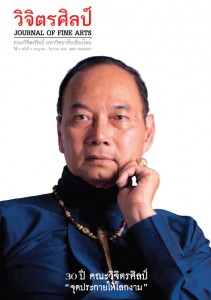จากทองคำเปลวสู่คัมภีร์พุทธประวัติ: ความเกี่ยวข้องกับภูมิภาคตะวันออกที่พบ ในงานจิตรกรรมฝาผนังพม่ายุคหลัง
Main Article Content
Abstract
บทความนี้ต้องการสำรวจแง่มุมเหล่านี้ในงานจิตรกรรมฝาผนังพม่าในระหว่างศตวรรษที่ 17 – 19 เพื่อสืบค้นการแพร่กระจายและผลกระทบเหล่านั้น ตลอดจนวิธีการอันหลากหลายทั้งทางด้านสังคม ศาสนา และการเมืองที่เกิดขึ้น ในท้ายที่สุดจิตรกรรมฝาผนังยังแสดงถึงมุมมองของชาวพม่าที่มีความมั่นใจในวัฒนธรรมของตนแต่ก็พร้อมที่จะรับเอาเนื้อหาบางอย่างจากภายนอก ส่วนหนึ่งเนื่องจากการมีศรัทธาร่วมกันในพระพุทธศาสนาและความสัมพันธ์ทางการเมืองที่เลื่อนไหลใน
From Gold Leaf to Buddhist Hagiographies: Contact with Regions to the East Seen in Late Burmese Murals.
In 1767 the Burmese army sacked the Thai city of Ayutthaya, and multitudes of people were captured and relocated to the Burmese central zone, including artists and theatrical performers. This event has been considered seminal in the emergence of Thai influences on Burmese art, including mural painting. Yet, Burmese deportations of people from the Thai, Lan Na, Sipsong Panna, and Shan States regions occurred on a number of occasions prior to the late eighteenth century attack. And, trade networks and religious exchanges between monasteries formed alternative routes of communication between Burma, Ayutthaya, Lan Na, Sipsong Panna, and the Shan States. Unsurprisingly, such variant interactions had an impact on artistic production in Burma prior to the destruction of Ayutthaya and the relocation of artists to the Ava region. The ideas utilized in Burmese murals range from central Thai elements of style and dress to narratives and methods of religious practice found particularly in Tai regions.
This paper explores these aspects in Burmese mural paintings from the seventeenth, eighteenth, and nineteenth centuries in order to suggest the extent and nature of this impact, as well as the various means - social, religious, political - by which it came about. The murals ultimately present a view of a culturally confident Burma readily absorbing external material due in part to shared religious beliefs and fluid political relationships in the region.


